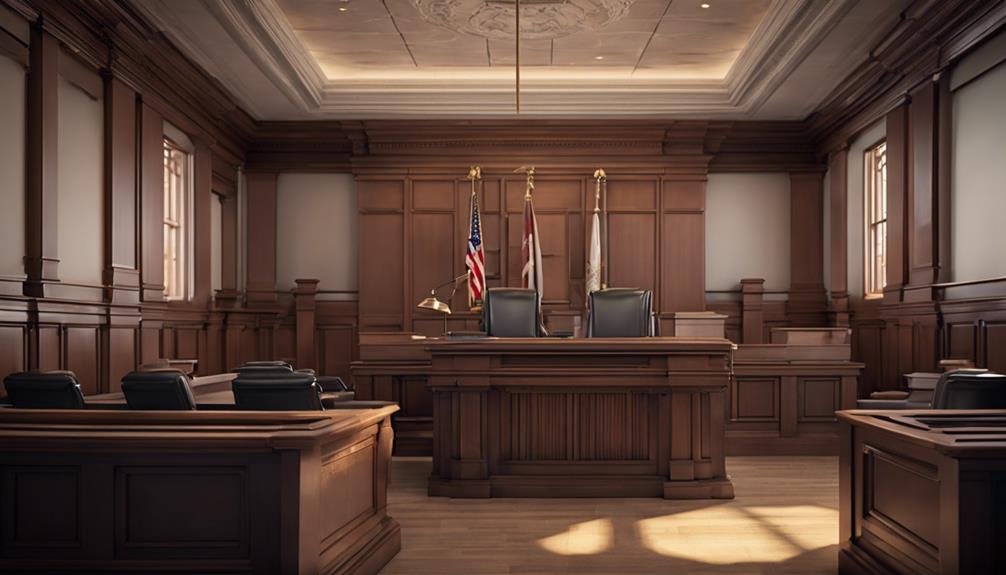Bankruptcy Court: Meaning, Procedures, Examples
Bankruptcy Court, governed by federal laws, handles bankruptcy cases for individuals and businesses, employing procedures to navigate financial complexities. The court aims to provide important resolutions adhering to the bankruptcy code. It involves understanding specific criteria, gathering financial records, and accurately completing necessary forms. Bankruptcy judges oversee cases, ensuring impartial interpretation of laws. Various chapters like Chapter 7 and Chapter 13 cater to distinct financial circumstances. Filing for bankruptcy impacts credit scores and has legal implications. Misconceptions exist regarding legal protections and creditor rights. Real-life examples showcase the significant role of Bankruptcy Court. Explore further for in-depth insights.
Key Takeaways
- Bankruptcy courts specialize in handling bankruptcy cases for individuals and businesses under federal laws.
- Filing procedures involve meeting specific criteria, gathering financial records, and submitting accurate forms.
- Bankruptcy court judges oversee cases with impartiality and are appointed by the United States Court of Appeals.
- Different chapters like Chapter 7, 13, and 11 cater to various financial situations for liquidation or reorganization.
- Filing for bankruptcy has implications on credit scores, privacy, creditor harassment, and legal repercussions.
Bankruptcy Court Definition
Specializing in handling bankruptcy cases for individuals and businesses, the bankruptcy court is a federal court system governed by specific federal laws established by Congress. The bankruptcy court jurisdiction extends to matters related to bankruptcy, including liquidation and reorganization processes. Within this jurisdiction, bankruptcy court hearings are conducted to assess debtors' financial situations, determine the eligibility for bankruptcy relief, and oversee the repayment or discharge of debts.
These hearings play an important role in the bankruptcy process, ensuring that all parties involved have the opportunity to present their cases and that the proceedings adhere to the applicable bankruptcy laws. Ultimately, the bankruptcy court's decisions aim to provide a fair resolution for debtors and creditors within the confines of the bankruptcy code.
Filing Procedures and Requirements
The filing of bankruptcy petitions in federal court requires adherence to specific procedures and requirements outlined by federal bankruptcy laws. When preparing to file for bankruptcy, individuals or businesses must be aware of the following:
- Filing Requirements: Understanding the specific criteria and eligibility standards for different bankruptcy chapters.
- Documentation Needed: Gathering essential financial records, tax returns, and asset information for the court.
- Court Forms: Completing and submitting the necessary bankruptcy forms accurately to initiate the legal process.
Ensuring compliance with these filing procedures and requirements is essential for a smooth bankruptcy petition process.
Bankruptcy Court Judges and Appointments
Bankruptcy court judges play a pivotal role in overseeing bankruptcy cases and ensuring fair adjudication of financial matters within the legal system. Judicial independence is vital for judges to impartially interpret and apply bankruptcy laws.
The appointment process for bankruptcy judges is conducted by the United States Court of Appeals, with appointments lasting 14 years. This process helps maintain the integrity of the judiciary system by selecting qualified individuals who demonstrate a deep understanding of bankruptcy laws and procedures.
Chapter Types and Their Applications
With distinct purposes and legal frameworks, various chapters of bankruptcy law cater to specific financial circumstances and objectives. When considering bankruptcy options, understanding the differences between Chapter 7 and Chapter 13 is essential. Additionally, for businesses seeking reorganization techniques, Chapter 11 offers a tailored approach to restructuring debts and continuing operations.
Here is a brief comparison between Chapter 7 and Chapter 13:
- Chapter 7: Involves liquidation bankruptcy for individuals or businesses, aiming to discharge debts by selling non-exempt assets.
- Chapter 13: Allows individuals to reorganize debts and establish a repayment plan over time.
- Business Reorganization Techniques: Chapter 11 provides a platform for businesses to restructure debts and operations, offering a chance for financial recovery.
Implications of Filing for Bankruptcy
Upon evaluating the distinctions between Chapter 7 and Chapter 13 bankruptcy, comprehending the implications of filing for bankruptcy becomes essential for individuals and businesses facing financial challenges. Filing for bankruptcy can have significant consequences, including a lasting impact on credit scores and various legal ramifications. Here is a table highlighting the key implications of filing for bankruptcy:
| Implications | Credit Impact | Legal Consequences |
|---|---|---|
| Privacy Concerns | Negative impact on credit scores for years | Loss of control over assets in liquidation bankruptcy |
| Financial Disclosure | Potential creditor harassment | Requirement for credit counseling before filing |
| Repayment Plans | Consequences on credit score and reputation | Individual cases vary in their best approach |
Understanding these implications is essential before deciding to pursue bankruptcy as a solution to financial difficulties.
Common Misconceptions in Bankruptcy Court
Misunderstandings and misconceptions often cloud the public's understanding of the intricacies of proceedings within the domain of bankruptcy court. To clarify common misconceptions regarding debtor protections and creditor rights, consider the following:
- Debtor Protections:
- Bankruptcy laws provide debtors with legal protections, such as the automatic stay that halts creditor collection actions.
- Debtors have the right to keep certain exempt assets, shielding them from being used to repay debts.
- Creditor Rights:
- Creditors retain rights to challenge the discharge of certain debts, ensuring fair treatment in the bankruptcy process.
- Creditors may have the ability to file claims to recover some or all of the debts owed to them.
Understanding these nuances is essential to maneuvering the complexities of bankruptcy court with clarity and accuracy.
Real-Life Bankruptcy Court Examples
Bankruptcy court proceedings offer valuable insights into real-life financial challenges faced by individuals and businesses. Case studies provide practical insights into how bankruptcy laws are applied in various situations.
For example, a Chapter 7 bankruptcy case study may illustrate the process of liquidating assets to repay creditors, while a Chapter 11 case study could demonstrate how businesses reorganize debts to continue operations. These real-life examples showcase the complexities of bankruptcy court proceedings, highlighting the importance of understanding federal bankruptcy laws and seeking legal counsel.
Conclusion
In summary, bankruptcy court acts as a legal lifeline, guiding individuals and businesses through the turbulent waters of financial distress.
Like a skilled navigator steering a ship through treacherous seas, bankruptcy court judges uphold federal laws to guarantee fair and equitable resolutions for debtors and creditors alike.
Understanding the intricacies of bankruptcy court procedures and outcomes is essential for those seeking to chart a course towards financial stability and a fresh start.







